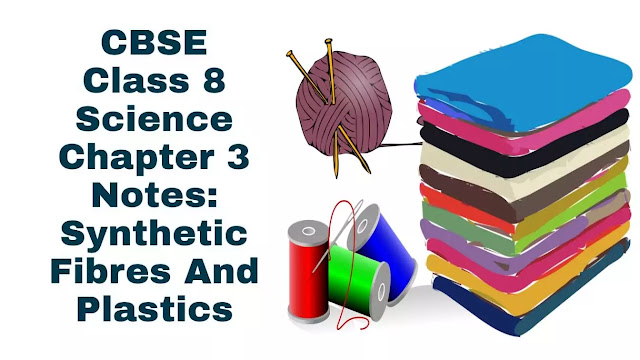CBSE Class 8 Science Revision Notes Chapter 3 - Synthetic Fibres and Plastics
Synthetic Fibres: The fibres that are made by human beings are called synthetic or man made fibres.
Synthetic fibre is made up of chain of small units joined together where each small unit is a chemical substance.
Polymer: Polymer is the large single unit made up of many small repeating units.
Cellulose: Cellulose is a natural polymer. Cellulose is made up of a large number of glucose units.
Types of synthetic fibres:
1.Rayon:
• Rayon is also known as artificial silk because it is very similar to natural silk. • It is obtained by chemical treatment of wood pulp.
• It is cheaper than natural silk.
• It is used to make bed sheets (rayon+cotton) and carpets (rayon+wool).
Nylon:
• It is prepared from coal, water and oil.
• It is strong elastic and light.
• It is lustrous (shiny) and easy to wash.
Articles made from nylon:
socks, rope, tents, toothbrushes, car seatbelts, sleeping bags, curtains etc.
• It is also used for making parachutes and ropes of rock climbing because of its stronger strength.
2. Polyester (Poly+ester):
Poly means many and ester is a chemical which have fruity smell.
• Polyester is made up of repeating units of a chemical called ester.
• Fabric made from polyester does not get wrinkled easily.
• Being easy to wash, it is suitable for making dress material.
Examples: Terylene, PET
• PET (Polyethylene terephthalate) is used for making bottles, utensils, films, wires etc.
3.Acrylic:
• It is very similar to natural wool.
• It is used for making sweaters, shawls and blankets.
• Clothes made from acrylic are cheaper than natural wool.
Polycot: It is a mixture of polyester and cotton.
Polywool: It is a mixture of polyester and wool.
Terrycot: It is a mixture of terylene and cotton.
• Petrochemicals are used as raw material in the preparation of synthetic fibres.
Characteristic of synthetic fibres:
• They dry up quickly.
• They are durable.
• They are less expensive (cheaper).
• They are easy to maintain and easily washable.
Plastics:
• Plastics is also a polymer like synthetic fibres.
• Plastics have two different types of arrangements of units:
1. Linear (straight chain)
2. Cross-linked ( branched chain)
• Thermoplastics:
which gets deformed easily on heating and can be bent easily are known as thermoplastic.
Example: Polythene, PVC
They are used for manufacturing toys, combs and various types of containers.
• Thermosetting plastics: Plastics which when moulded once cannot be softened by heating. They cannot be bent.
Examples: Bakelite, Melamine
• Bakelite is a poor conductor of heat and electricity. It is used for making electrical switches and handles of various utensils.
• Melamine is a versatile (having many uses) material.It resists fire and can tolerate heat better than other plastics. It is used for making floor tiles, kitchenware and fabric which resist fire.
• Plastic containers are most convenient in storing food items, water,milk, pickles etc. because of their light weight, lower price and good strength.
Characteristic properties of plastics:
1.Plastic is non reactive. They are not corroded easily.That is why they are used to store various kind of materials including many chemicals.
2. Plastic is very light, strong and durable. They are widely used in industry and for household articles.
3. Plastics are poor conductor of heat and electricity. That is why electrical wires have plastic covering.
• Teflon is a special plastic on which oil and water do not stick. It is used for non-stick coating on cookwares.
• Biodegradable: A material which gets decomposed through natural processes, such as action by bacteria called biodegradable.
• Non-biodegradable: A material which is not easily decomposed by natural processes is called non-biodegradable.
Disadvantage of plastics:
1. Plastic takes several years to decompose.
2. It is not environment friendly.
3. On burning plastics, it releases lots of poisonous gases into the atmosphere.
4. It causes environmental pollution.
Steps should be taken to save the environment from plastic:
1. Avoid the use of plastics as far as possible.
2. Make use of bags made of cotton or jute.
3. Seperate biodegradable and non-biodegradable wastes and dispose them separately.
4. Recycle plastic wastes.
5-R principle:
1. Reduce: use less
2. Reuse: use again and again
3. Recycle: make again useful things from wastes.
4. Recover: making again reusable
5. Refuse: stop using Plastics
%20(2)%20(1).webp)

Best revision notes.
ReplyDeletePlease provide all chapters notes.
First of all Thanks for your positive feedback. Soon I will provide you all chapters notes.
DeletePost a Comment